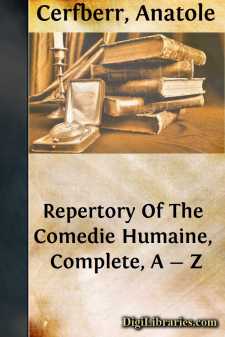Categories
- Antiques & Collectibles 13
- Architecture 36
- Art 48
- Bibles 22
- Biography & Autobiography 813
- Body, Mind & Spirit 142
- Business & Economics 28
- Children's Books 15
- Children's Fiction 12
- Computers 4
- Cooking 94
- Crafts & Hobbies 4
- Drama 346
- Education 46
- Family & Relationships 57
- Fiction 11828
- Games 19
- Gardening 17
- Health & Fitness 34
- History 1377
- House & Home 1
- Humor 147
- Juvenile Fiction 1873
- Juvenile Nonfiction 202
- Language Arts & Disciplines 88
- Law 16
- Literary Collections 686
- Literary Criticism 179
- Mathematics 13
- Medical 41
- Music 40
- Nature 179
- Non-Classifiable 1768
- Performing Arts 7
- Periodicals 1453
- Philosophy 64
- Photography 2
- Poetry 896
- Political Science 203
- Psychology 42
- Reference 154
- Religion 513
- Science 126
- Self-Help 84
- Social Science 81
- Sports & Recreation 34
- Study Aids 3
- Technology & Engineering 59
- Transportation 23
- Travel 463
- True Crime 29
Repertory of the Comedie Humaine Part 2
by: Anatole Cerfberr
Categories:
Description:
Excerpt
LA BASTIE LA BRIERE (Ernest de), member of a good family of Toulouse, born in 1802; very similar in appearance to Louis XIII.; from 1824 to 1829, private secretary to the minister of finances. On the advice of Madame d'Espard, and thus being of service to Eleonore de Chaulieu, he became secretary to Melchior de Canalis and, at the same time, referendary of the Cour des Comptes. He became a chevalier of the Legion of Honor. In 1829 he conducted for Canalis a love romance by correspondence, the heroine of the affair being Marie-Modeste-Mignon de la Bastie (of Havre). He played this part so successfully that she fell in love and marriage was agreed upon. This union, which made him the wealthy Vicomte de la Bastie la Briere, was effected the following February in 1830. Canalis and the minister of 1824 were witnesses for Ernest de la Briere, who fully deserved his good fortune. [The Government Clerks. Modeste Mignon.]
LA BASTIE LA BRIERE (Madame Ernest de), wife of the preceding, born Marie-Modeste Mignon about 1809, younger daughter of Charles Mignon de la Bastie and of Bettina Mignon de la Bastie—born Wallenrod. In 1829, while living with her family at Havre, with the same love, evoked by a passion for literature, which Bettina Brentano d'Arnim conceived for Goethe, she fell in love with Melchior de Canalis; she wrote frequently to the poet in secret, and he responded through the medium of Ernest de la Briere; thus there sprang up between the young girl and the secretary a mutual love which resulted in marriage. The witnesses for Marie-Modeste Mignon were the Duc d'Herouville and Doctor Desplein. As one of the most envied women in Parisian circles, in the time of Louis Philippe, she became the close friend of Mesdames de l'Estorade and Popinot. [Modeste Mignon. The Member for Arcis. Cousin Betty.] La Bastie is sometimes written La Batie.
LA BAUDRAYE[*] (Jean-Athanase-Polydore Milaud de), born in 1780 in Berry, descended from the simple family of Milaud, recently enobled. M. de la Baudraye's father was a good financier of pleasing disposition; his mother was a Casteran la Tour. He was in poor health, his weak constitution being the heritage left him by an immoral father. His father, on dying, also left him a large number of notes to which were affixed the noble signatures of the emigrated aristocracy. His avarice aroused, Polydore de la Baudraye occupied himself, at the time of the Restoration, with collecting these notes; he made frequent trips to Paris; negotiated with Clement Chardin des Lupeaulx at the Hotel de Mayence; obtained, under a promise, afterwards executed, to sell them profitably, some positions and titles, and became successively auditor of the seals, baron, officer of the Legion of Honor and master of petitions. The individual receivership of Sancerre, which became his also, was bought by Gravier. M. de la Baudraye did not leave Sancerre; he married towards 1823 Mademoiselle Dinah Piedefer, became a person of large property following his acquisition to the castle and estate of Anzy, settled this property with the title upon a natural son of his wife; he so worked upon her feelings as to get from her the power of attorney and signature, sailed for America, and became rich through a large patrimony left him by Silas Piedefer—1836-42. At that time he owned in Paris a stately mansion, on rue de l'Arcade, and upon winning back his wife, who had left him, he placed her in it as mistress. He now became count, commander of the Legion of Honor, and peer of France. Frederic de Nucingen received him as such and served him as sponsor, when, in the summer of 1842, the death of Ferdinand d'Orleans necessitated the presence of M. de la Baudraye at Luxembourg. [The Muse of the Department.]
[*] The motto on the Baudraye coat-of-arms was: "Deo patet sic fides et hominibus."
LA BAUDRAYE (Madame Polydore Milaud de), wife of the preceding, born Dinah Piedefer in 1807 or 1808 in Berry; daughter of the Calvinist, Moise Piedefer; niece of Silas Piedefer, from whom she inherited a fortune....




